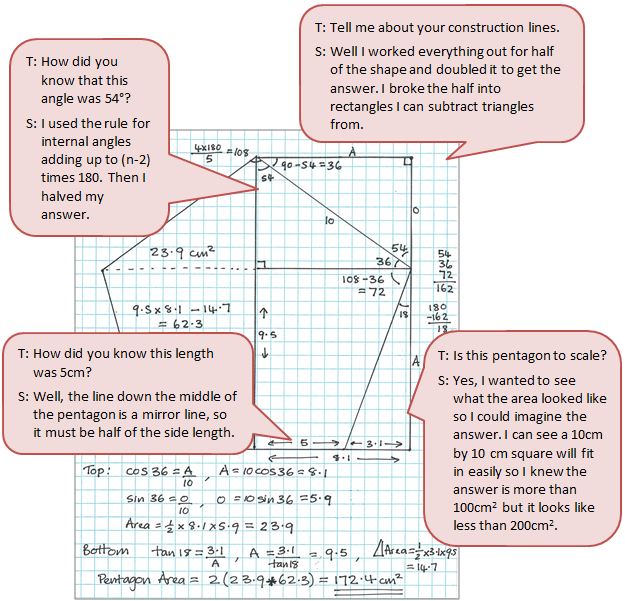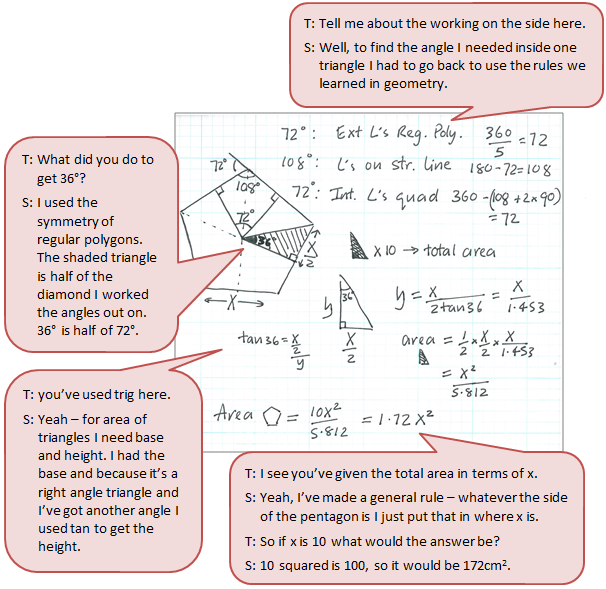The purpose of this activity is to engage students in a task that requires them to apply geometric properties of polygons and right angles triangle techniques in solving for the area of a polygon.
This activity assumes the students have experience in the following areas:
- Simple trigonometry, including Pythagoras’ Theorem and ratios to find side lengths and angles.
- Areas of triangles.
- Angles around a point and interior angles of polygons.
- Areas of composite shapes.
The problem is sufficiently open ended to allow the students freedom of choice in their approach. It may be scaffolded with guidance that leads to a solution, and/or the students might be given the opportunity to solve the problem independently.
The example responses at the end of the resource give an indication of the kind of response to expect from students who approach the problem in particular ways.
Task: By breaking down into triangles and/or rectangles, find the area of a regular pentagon of side length 10 cm.
The following prompts illustrate how this activity can be structured around the phases of the Mathematics Investigation Cycle.
Make sense
Introduce the problem. Allow students time to read it and discuss in pairs or small groups.
- What are the important words and symbols? (What is meant by a ‘regular’ pentagon? How long is each side?)
- Can I draw or sketch the situation? (Creating a scale drawing on 1 cm squared paper give a sense of the area of the pentagon. Students also consider the interior angles to draw the pentagon.)
- What do I need to find out? (Students need to find the area of a specific pentagon.)
- Is it about how many or how much? (Students need to consider what an answer might look like and how it will be expressed, e.g., 400 cm2.)
Plan approach
Discuss ideas about how to solve the problem. Emphasise that, in the planning phase, you want students to say how they would solve the problem, not to actually solve it.
- What are the maths skills I need to work this out? (Since the pentagon is likely to be divided into triangles and trapezia, knowing how to find sides, angles, and areas of these polygons will be important.)
- What could the solution be? What is a sensible estimate? (The scale drawing will help create a reasonable estimate.)
- How could I show this problem using numbers, pictures, graphs, tables, or materials? (Students will need to draw how the pentagon can be partitioned into workable shapes.)
- What strategies can I use to get started? (Symmetry of the pentagon can be used to simplify the calculations.)
- Can I notice a pattern to write down and explore? (Interior angles of regular polygons conform to a pattern. The angles add to (n – 2) x 180◦ and this sum can be divided by n to find the size of each angle.)
- What tools (digital or physical) could help my investigation? (A scientific calculator with trigonometric functions is essential.)
Take action
Allow students time to work through their strategy and find a solution to the problem.
- Have I shown my workings in a step-by-step way? (Are the partitions obvious in a diagram? Is it clear how each angle and side length is calculated?)
- Do I know how to use my tools or should I ask for help?
- Does my answer seem correct? Is it close to my estimation?
- How could I make sure that I haven’t missed anything?
- Is there another possible answer or way to solve it? (There are many possible ways to partition the regular pentagon.)
Convince yourself and others
Allow students time to check their answers and then either have them pair share with other groups or ask for volunteers to share their solution with the class.
- What is the solution?
- Show and explain how you worked out your solution.
- Can others see how I worked it out?
- How does my solution answer the question?
- Would my strategy work in a different situation? (For example, finding the area of other regular polygons.)
- Is there some mathematics that I would like to be able to do that I can't do currently?
- What have I noticed that seems to work all the time? (Creating right-angled triangles and trapezia is a productive strategy.)
Examples of work
Work sample 1
The student applies geometric properties of polygons and uses trigonometric ratios to find an unknown area.
Click on the image to enlarge it. Click again to close.
Work sample 2
The student divides a regular polygon into composite triangles and rectangles and applies geometric properties of polygons and uses trigonometric ratios and Pythagoras' theorem to find an unknown area.
Click on the image to enlarge it. Click again to close.
Work sample 3
The student divides a regular polygon into composite triangles and rectangles and applies geometric properties of polygons and uses trigonometric ratios and Pythagoras' theorem to find an unknown area.



